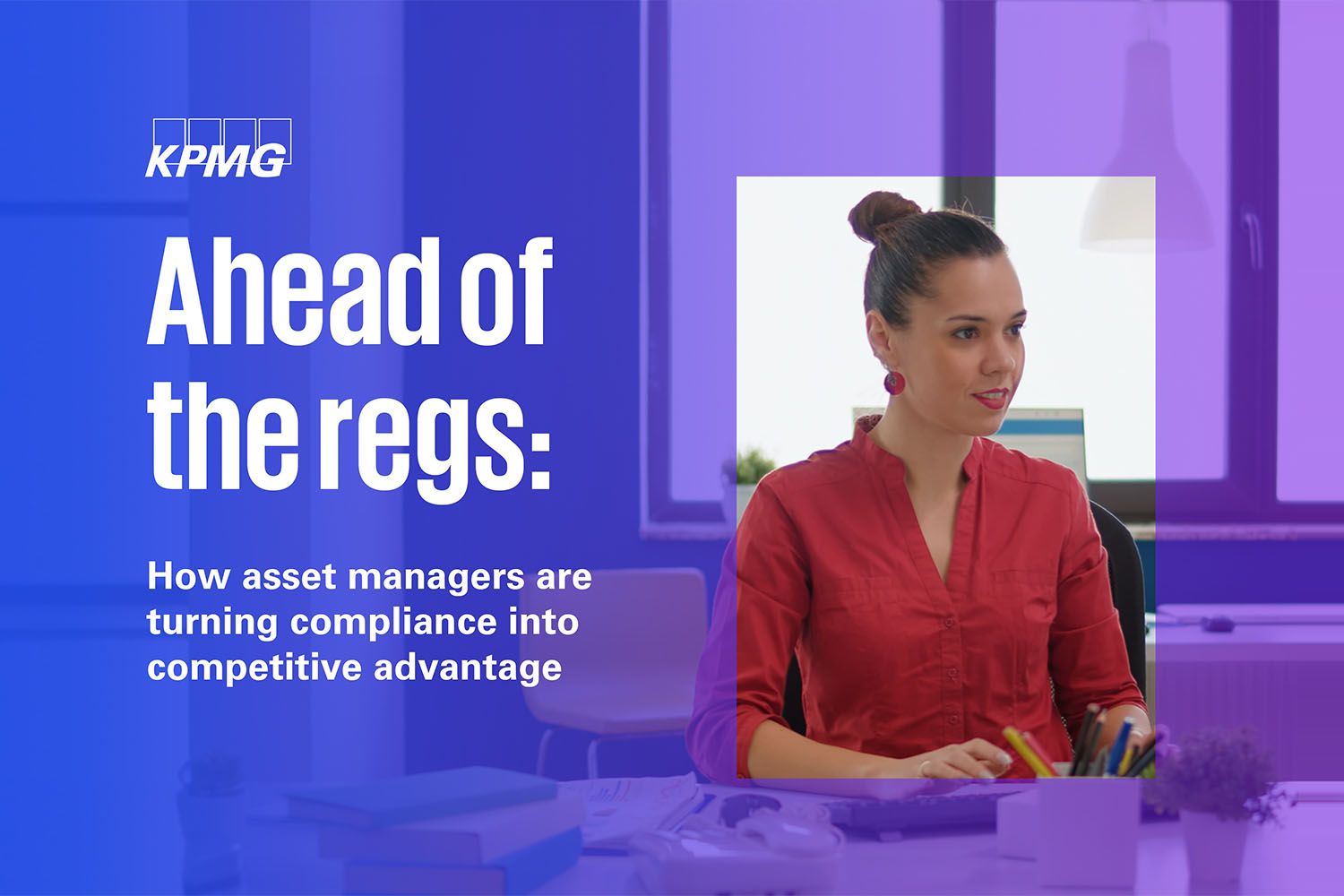As regulators and tax authorities become more active and far-reaching, many Asset Managers are asking how they can move from ambition to action on their regulatory strategy.
You likely didn’t go into investment management because you had a deep passion for dealing with complex tax and regulatory issues. But – if you are like most fund managers – you are probably spending more and more of your time thinking about compliance. At times, it may seem overwhelming.

Ahead of the regs:
How asset managers are turning compliance into competitive advantage
Download PDF (1.83 MB) ⤓
You are not alone
In part, the problem is quantity. The Asset Management sector is among the most heavily regulated in the world. You will certainly be beholden to a morass of local prudential and consumer regulations in your home market. Depending on where you operate, invest and raise funds, you may also be subject to a range of different regulations or tax codes across a number of different jurisdictions. At the same time, you need to be on top of global initiatives like the OECD’s Base Erosion and Profit Shifting (BEPS) initiative which includes Pillar One and Pillar Two, as well as the Global Minimum Tax proposal.
The problem also comes down to complexity. While most financial regulators and tax authorities essentially want the same thing – a safe, well-functioning and transparent Asset Management sector – they often go about it in different ways. Recently, for example, around climate and energy, in the US, tax authorities and policymakers lean toward the ‘carrot’ of incentives in an attempt to catch up with the EU’s energy policy progress. However in the EU, on the other hand, the preference leans towards a ‘stick’ that carries enforcement penalties to help reinforce already adopted policies. Even where there is consensus at the macro level (like with the Global Minimum Tax) the application can vary widely across markets.
Then there is the pace of change. As markets evolve and new, innovative technologies emerge, regulators and tax authorities are moving as quickly as they can to respond. Consider, for example, the range of new regulations and requirements being promulgated around ESG and climate globally. Faster moving issues like the use of generative AI in decision making will soon spawn a new raft of regulations and changes to the tax codes.
With all of that comes an air of uncertainty. The reality is that most regulators are playing catch-up on many of the key issues influencing the AM sector today. What that means is that, in many areas, Asset Managers are being left to decipher how the current and future rules might apply, what standards might be expected of them and how to innovate responsibly within the (yet unwritten) rules.
Don’t put this off
The risks of getting compliance wrong are obvious. Regulators and tax authorities possess an armory of enforcement weapons they can level at an organization that runs afoul of the rules. Audits and reviews can be time consuming, distracting and costly. A poor track record for compliance engenders mistrust by the regulator and can often attract additional levels of scrutiny at every step in the regulator/regulated relationship. And nobody wants to be the lead story on the business feed for regulatory non-compliance.
Investors also increasingly view regulatory and tax compliance as a key part of their due diligence when investing with managers. They want to see that the prospective manager is thinking carefully about the long-term implications of regulation and proactively preparing. What they really don’t want to see is a history of regulatory infractions and enforcement actions.
Your regulatory capabilities can also significantly influence future growth. If your firm lacks capabilities in ESG compliance and reporting, for example, you may struggle to launch a new impact fund into the market. If crypto regulation confounds you, you may be less willing to see digital assets as an investable asset class. This isn’t just about giving you the confidence to innovate, it’s also about giving your investors confidence that you can innovate safely and within the guidelines.
Take a strategic approach
In this environment, what Asset Managers need is an agile but practical strategy. The importance of taking a strategic approach cannot be understated. Dealing with tax and regulatory change on a case-by-case basis or as a compliance check-box exercise will likely never give you the insight and efficiency you need to get ahead of expectations. Yet, at the same time, your strategy must be agile enough to be able to flex and adapt as new considerations and requirements arise.
No two strategies will be exactly alike. Indeed, a range of different considerations will likely influence how Asset Managers plan and execute their strategy. One big one is data and reporting. For the time being, different stakeholders require different types of data for reporting. Think of the current state of tax reporting, for example.
Another key consideration is human resources and capability. Few firms have the in-house skills or bench strength to adequately cover all the bases. And, given the current talent shortage globally (and particularly within technical skill areas like specific regulation affecting Asset Managers), finding the right resources and capabilities can be a massive challenge. That means Asset Managers should be very strategic about where they focus their resources and what capabilities they keep in-house.
They should also expect to base their strategy on where they believe their tax and regulatory authorities are going in order to help ensure what they are creating is sustainable and fit for the future. Not everything can be predicted, but some trends certainly can. For example, we are now starting to see some tax authorities move to real-time tax calculations and payments, particularly for indirect taxes. It likely won’t be long before direct tax authorities and regulators start wanting to ‘reach in’ to other enterprise systems in order to pull the data they need rather than waiting for it to be pushed.
The other big consideration is your organization’s ability to change. It takes dedicated attention, experience and deep capabilities to design, activate and maintain a large change program. Few firms likely have the program management, integration or transformation skills that may be required in-house. Sometimes the biggest barrier is simply in the organization’s ability to turn ambition into action.
Move from ambition to action
That’s where most Asset Managers are struggling today. Most leaders KPMG professionals speak with say they want to take a more strategic approach to regulatory and tax compliance. They just aren’t sure how to get from here to there.
KPMG professionals’ experience helping Asset Managers design, activate and maintain their regulatory strategy suggests there are five key steps to success.
1. Understand the environment and how it is changing
Based on your organizational strategy and growth objectives, start by identifying your key tax and regulatory stakeholders across current and future jurisdictions. Consider how their regulatory focus and expectations are changing. Think about new and emerging areas of regulatory interest and how they might intersect with your objectives and operating models.
2. Know where you want to go.
Based on your understanding of the environment, your future growth objectives and a realistic assessment of your organization’s current capabilities and capacity, define your future operating model for regulatory and tax compliance. Think about which capabilities you would see as being ‘core’ to your business and which might provide you with a competitive advantage in the future.
3. Look for leading practices and tested approaches
Understand how other organizations have achieved similar objectives. Keep an open mind to different technologies and operating models that could be adapted. Talk to industry leaders and advisors about their experience. Explore the different in-market solutions and vendors that could support your transformation. Don’t limit yourself to peers in your region or sector.
4. Develop your roadmap
At this point, you should have everything you need to develop a robust roadmap. But the idea is to keep it flexible and agile – like your favorite navigation app does, the point is to keep the destination in mind, but to be flexible and aware enough to be able to adapt as roadblocks appear or as new routes to your destination become available. More often than not, that will likely mean smaller sprints and agile approaches.
5.Execute with support.
Recognize where you might need additional support designing, executing and maintaining your strategy. Think carefully about what types of skills and capabilities you might need through the transition and into the new steady state of operations. Where possible, lean on advisors with deep experience in your markets and extensive relationships with appropriate regulatory and tax authorities.
Getting ahead of the regulations
While this may seem like a period of heightened regulatory and tax scrutiny and action, the reality is that the pace of change and level of action is only expected to increase in the coming years. That means that Asset Managers really need to be proactive about how they plan to respond over the long-term. The sooner you develop your plan and activate it, the sooner you can start to hire the right people, initiate appropriate technology programs and collect the necessary data, for example. Simply put, the longer you wait, the more difficult, painful and costly change becomes.
One of the only ways for Asset Managers to survive and thrive in this environment is with a practical strategic plan, an agile approach to transformation and deep insight into the future direction of travel. It’s time to turn compliance into competitive advantage.
Get in touch
Connect with us
- Find office locations kpmg.findOfficeLocations
- kpmg.emailUs
- Social media @ KPMG kpmg.socialMedia




